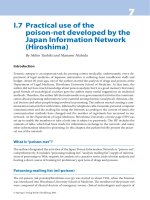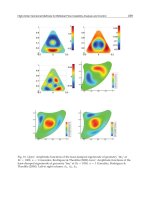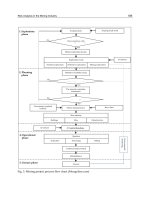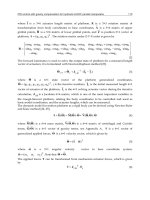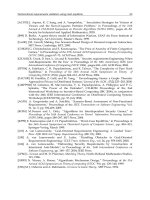Theory of Brain Function quantum mechanics and superstrings - part 7 pptx
Bạn đang xem bản rút gọn của tài liệu. Xem và tải ngay bản đầy đủ của tài liệu tại đây (111.49 KB, 8 trang )
57
world, it comes to rest and focuses its attention upon the object or danger. Ideas and
memories, i.e., mental representations of past experiences, are summoned form the
preconscious to help the person adjust to the situation confronting him. When the
danger is past or the need is satisfied, the mind turns its attention to other matters
[108, 109].
Concerning the nature of the “unconscious proper”, Freud suggested [109] that
“threatening” events could be repressed in memory so that they were not ordinarily
available for conscious recall. Freud’s analysis of repression, the selective inability
to recall, is a form of Darwinism ( survival of the fittest) as applied to t he mental
world to become the Freudian suppression of the “threatening”. “Threatening” events
belong to the set of the “unconscious proper events”. Freud developed further [108,
109] a theory about the fate of the repressed events, connecting them, partially, to
dreams! Dreams are filled with disguised or symbolic representations of repressed
desires. When the disguise becomes too transparent, the dreamer usually wakes
up. Anxiety dreams and nightmares, for example, are caused by the emergence
of repressed desires which makes the person anxious. He noticed that somatically,
sleep is an act which reproduces intra-uterine existence,
5
fulfilling the condition of
repose, warmth and absence of stimulus. The feature characterizing the mind of a
sleeping person is an almost complete withdrawal from the surrounding world and
the cessation of all interest in it. Freud pictured [109] the situation which leads to
dream formation as follows: the preconscious dream-wish is formed, which expresses
the uncons c ious impulse in the material of the preconscious day-residues. This dream-
wish must be sharply distinguished from the day-residues, it need not have existed
in waking life and it may already display the irrational character, e.g., a person in
the dream is t he mixture of two or three rather similar people, etc, noticeable in all
that is unconscious when we come to translate it into terms of consciousness! The
logical validity, freshness, and stunning resemblance to our presently holding views
about brain function, characterizing Freudian psychology [108, 109 ], are properties
very hard to miss. Since his time, ample evidence has accumulated from the study of
neurosis, hypnotism, and parapraxes to show that his basic views about the action of
the unconscious and its role in behavior, were essentially correct.
After our, hopefully, enjoyable and useful excursion to Freud-land, we have all
that is needed to complete the above-discussed isomorphism between mental events
and neural patterns, described by MT-quantum states. Freud’s psychic energy as
opposed to bodily energy and the transformation into each other, corresponds to the
exchange of energy/interactions between the W
1
-world or attainable physical world
localiz able states and the W
2
-world or global states, as explicitly indicated in (27).
Notice, as (25) explicitly shows, that there is conservation of energy in our scheme!
Furthermore, the “preparation” of the relevant superimposed MT-quantum states de-
pends on the nature and intensity of the stimulus, as discussed in sections 2,4,7,8,
i.e., if it can “easily” “straigthen up” the relevant states, corresponding to a precon-
5
There is, presently, evidence to suggest that in the womb, especially in the third trimester,
Dream or REM sleep occurs more than 8 hours a day [1 07].
58
scious state, or if , it can “hardly” have any effect on the states, corresponding to
“unconscious proper” states. In the case of preconscio us states, identifiable with the
relevant superimposed quantum states, synchordic collapse follows easily, turning it
into a conscious state! In the case of “unconsci ous proper” states, identifiable with
either isolated, not easily reproduced, or random states, nothing happens! Clearly,
there is a continous spectrum of quantum states f r om the “preconscious” to the “un-
conscious proper”. In the case that an “unconscious proper” stata gets “prepared”,
then synchordic collapse leads to Freud’s “threatening events”. For example, while
we sleep being “off guard”, “unconscious proper” states may be partially and para -
sitically prepared, even in disguised form, and may lead to nightmares! On the other
hand, synchordic collapse, of variable effectiveness, of presumably partially parasit-
ically pre pared preconscious dream-states, as discussed in the previous section (see
Fig. 1(d)) reproduces Freud’s basic views about dream formation discussed above.
If our dynamical theory of brain function, with its now completed isomorphism be-
tween mental events and MT-quantum dynamics states has not reproduced, almost
verbatim the basic elements of Freudian psychology, I don’t know what would ever
do. Needless to say, Freud’s terms are psychological, while ours are structural. It is in
this sense that we consider the mental world somehow iso morphic to the W
2
-world of
physical global states that help to “prepare” and eventually dismantle, by “synchordic
collapse”, the relevant superimposed MT-quantum states of the W
1
-attainable phys-
ical world constituted by tubulin-dimer conformational states, as depicted clearly in
(2) and (27). It should be mentioned here (see relevant discussions in sections 6,8 ) the
rather fundamental role played by the K-code(s) [5 7] possessed by the microtubules,
in advancing and completing our isomrphism between the mental world and the W
2
-
world, by acting as a dictionary translating psychol ogical orders into physiological
actions. It is in this sense that I propose to call the K-code(s), the Mental Code,
playing in a way the role of the genetic code, but in the mental world. It should be
stressed once more here (see the appropriate discussion in section 5, between (22) and
(23), that there is nothing mystical or supernatural about the W
2
world global states,
or the way they interact with the W
1
-world attainable physical states, except that,
due to their delocalized nature, sometimes, a bit different than normal, novel proper-
ties may emerge! Through the above mentioned isomorphism, these novel properties
are transmitted to the mental world, which thus is an (emerging) part of the phys-
ical world, but with (inherited) distinct qualities. Notice further, that in particle
physics at very high energies, we only talk about electroweak interactions, and only
at low energies we may talk about “effective” electromagnetic and weak interactions.
Similarly here and in a unified theory sense, we should talk only about the physical
world (W ) when all states, localized and delocalized are accounted fo r (2,27), and only
talk about the attainable physical world (W
1
) and the mental world and their inter-
actions, i.e., an effectively emerging dual world (1), only when the delocalized states
get truncated, which happens realistically most of the time! Incidentally, if all these
kind of (post) modern views sound pretty drastic, let me remind you that Empedoc l e s
(490-430 B.C.), the famous, ancient greek, presocratic philosopher, in his “cosmic
phantasy”, ascribed to the whole universe the same animistic principle as is mani-
59
fested in each individual organism! If he was not describing, in his way, the W
2
-world
global, delocalized states, I don’t know whatever would do better. He certainly was
the first complete effective dualist! Hopefully, this emerging compromising resolution
of the age-old problem concerning the brain-mind relation, will bring peace, once and
for all, to the different quarters of dualists and non-dualists, and avoid f urther duels!
Nevertheless, as I already mentioned in the Introduction (just after (2)), hard-core
materialists may, if they so wish, concentrate their attention on the physical rela-
tion/transition between the W-physical world and the W
1
-attainable physical world.
It is immaterial to me!
The interface between psychology and physics (psychophysics) has always been
rather interesting, though-provoking, challenging, sometimes controversial, but cer-
tainly not dull. Before Darwin, man was set apart from the rest of the animal kingdom
by virtue of having a soul. The evolutionary doctrine made man a part of nature, an
animal among other animals. Man became an object of scientific study, no different
save in complexity, f rom other forms of life. Literally at the same time (1860), Fechner
founded the science of psychology, by showing that the mind could be studied scien-
tifically and that it could be measured quantitatively. At about the same t ime, the
physical formulation of the principle of conserv ation of energy, notably by Helmholtz,
stating that energy is a quantity that can be transformed, but it cannot be destroyed,
had rather far reaching consequences for biology and psychology. It made possible
an even more radical view of man. This is the view that man is an energy system
which obeys the same physical laws that regulate, say, the fall of an apple o r electro-
magnetic phenomena. Thanks to Freud’s genius, the physical dynamics extended to
apply to man’s pe rsonality, and not only to her/his body. This really amazing vision-
ary step, as t aken by Freud, led to dynami cal psychology [108], i.e., one that studies
transformation and exchanges of energy within the personality, as well as b etween
the personality and the body. It is an amusing coincidence to notice that Freud’s
chef d’oevre “ The Interpretation of Dreams” [108 ], and Planck’s revolutionary paper
on energy quantization, both appeared in 1900 (!), and both after considerable hesi-
tation and self-doubt!!! The dynamical scheme presented here, is nothing more than
a supermodest attempt to continue the psychophysical tradition described ab ove, by
combining the most recent advances in quantum dynamics, as described in non-critical
sup erstring theory [5 , 6, 7], with the amazing progress in microtubules and their dy-
namics [1]–[4]. A unified scheme of brain-mind dynamics emerges, consistent with
all known laws o f physics, notably including the law of conservation of energy, and
at the same time, providing satisfactory answers to age-old problems such as what
is consciousness, the binding problem or unitary sense o f self, free-wi ll and the like,
involving parts or the entire activity of the brain. Indeed, conscious thoughts seem
to correspond to metastable states of the brain associated with particular integrated
patterns of neural excitations, that are selected by synchordic collapse, from among a
plethora of such neural patterns described by MT-network states (quantum) mechan-
ically generated according to (3,4). Since synchordic collapse is due to the truncation
of global delocaliz ed states, our consciousness is nothing else but a localized aspect of
a global, integrative process. There is a new image of man emerging, in which hu-
60
man consciousness is placed in the inner workings of a non-local global process that
link the whole universe together, defying classical physics and observations of usual
everyday life. It seems, that we are intimately and integrally connected into the same
global process that is actively creating the form of the universe, as we suggested in
[52], thus providing a whole new meaning to the, presently fashionable, expression
global village. There seems to be a central organizing principle at work, essentially
what I called the Protean Principl e at the end of my review “As time goes by ”
[6]. This new view of man’s place in the universe is an essential “paradigm shift”.
We are not just small, irrelevant, struggling for survival creatures in a meaningless
universe, but through our dynamically created consciousness, we participate actively
in the intrinsically global process tha t forms the world around us. We are brains
with strings attached! I do believe that this, scientifically geared, “paradigm shift”
in our Weltanschauung, or “world view”, is bo und to have a tremendous impact, but
mostly presently unimaginable, in all forms of human behavior form the individual to
the social level. Some visionary people have already started talking abo ut the dawn
of the brain man, at the dawn of third wave [110] of civilization, characterized by
strongly declining muscle work and fastly increasing brain work, that succeeds the
“secon d wave ” related to the industrial revolution of 300 years ago, and which in turn
succeeded the “first wave” related to the agricultural revolution of 10,000 years ago,
This is just the dawn of the Homo Quantum
Acknowledgements
It is a great pleasure to thank: my collaborators, John Ellis and Nick Mavromatos
for stimulating discussions on some of the topics discussed here and the latter also
for reading the manuscript; Jorge Lopez fo r discussions, reading the manuscript, and
help with the figure; Steve Kelley, Stuart Hameroff, and E. Roy John for informative
discussions; David Norton for discussions, encouragement and support, throughout
this work; Skip Porter for continuous interest in this project, and Gil Marques for
the warm hospitality extended to my wife and myself during our visit to Brazil. This
work has been supported in part by DOE grant DE-FG05-91-ER-40633.
62
[13] H. P. Stapp, Mind, Matter and Quantum Mechanics ( Springer-Verlag, New
York, 1993).
[14] N. Goldenfeld, Lectures on Phase Transitions and the Renormalization Group
(Addison-Wesley, New York, 1992).
[15] E. R. John, Science 177 (1972) 850; E. R. John, F. Bartlett, M. Shimikochi,
and D. Kleinman, Journal of Neurophysiology 36 (1973) 893; F. Ba r t lett and
E. R. John, Science 181 (1973 ) 764; E. R. John, in The PsychoBiology of Con-
sciousness, ed. by R. J. and J. M. Davidson (Plenum Publishing Corporation,
New York, 1980) p. 129.
[16] B. McA. Sayers, H. A. Beagley, and W. R. Henshall, Nature 247 (1974) 481;
B. McA. Sayers and H. A. Beagley, Nature 260 (1976) 461.
[17] C. Darwin, On the origin of s pecies by means of natural sel ection or the preser-
vation of favoured faces in the struggle for lif e (Murray, London, 1859).
[18] J. D. Watson and F. Crick, Nature 171 (1953) 737, ibid 964.
[19] E. Chargaff, Experientia 6 (1950) 201; Fed. Proc. 10 (1951) 654;
J. Cell. Comp. Physiol. 38 (1951) 41.
[20] For a readable and enjoyable account of the basics of quantum mechanics see:
R. P. Feynman, R. Leighton, and M. Sands, The Feynman Lectures on Physics,
Volume III (Addison-Wesley, 1963).
[21] W. Heisenberg, Zeitschr. Phys. 43 (1927) 172.
[22] A. Einstein, B. Podolsky, and N. Rosen, Phys. Rev. 47 (1935) 777.
[23] For a review see: A. Aspect and P. Grangier, “Experiments on EPR-type corre-
lations with pairs of visible photo ns”, in Quantum Concepts in Space and Time,
edited by R. Penrose and C. J. Isham (Oxford University Press, 1986).
[24] E. R. Kandel and J. H. Schwartz, Prin ciples of Neural Sciences (Appleton
and Lange, Norwalk, Conn, 1991), 3rd edition; V. Braitenb erg and A. Shulz,
Anatomy of the Cortex (Springer-Verlag, Berlin, 1991).
[25] G. M. Edelman, Bright air, brilliant fire (BasicBooks, New York, 1992 ).
[26] D. O. Hebb, The org anization of behavior (Wiley, New York, 1949), and Essay
on Mind (Lawrence Erlbaum Associates, Hillsdale, N.J. 198 0).
[27] For an introductory book see: T. Khanna, Foundations of Neural Networks
(Addisson-Wesley, 1990).
[28] J. J. Hopfield, Proc. Nat. Acad. Scien. USA 79 (1982) 2554, ibid 81 (1984)
3088; Phys. Today, 47 (February 1994), p. 40, and reference therein.
63
[29] M. M´ezard, G. Parisi, and M. Virasoro, Spingla s s theory and beyond (World
Scientific, Singapore, 1987); D. J. Amit, Modelin g brain function (Cambridge
University Press, Cambridge, 1989) ; D. L. Stein, Spin glasses in biology (World
Scientific, Singapore, 1992).
[30] R. Descartes, Meditations on first philosophy, ed. S. Tweyman (Routledge, Lon-
don, 1993), from the original Medidationes de prime philosophi a (Paris, 1641 ) .
[31] P. M. Milner, Phychol. Rev. 81 (1974) 521; C. Von der Marlsburg and
W. Schneider, Biol. Cybern. 54 (1986) 29.
[32] F. Crick, The Astonishing Hypothesis (Charles Scribner’s Sons, New York,
1994).
[33] C. M. Cray and W. Singer, Proc. Nat. Acad. Sci. USA 86 (1989) 1698; R. Eck-
horn, et. al., Biol. Cyb ern. 60 (1988) 121; C. M. Cray, et. al., Nature 338 (1989)
334; A. K. Engel, e t. al., Proc. Nat. Aca. Sci. USA 88 (1991) 6048 and Science
252 (1991) 1177.
[34] For a review see: W. Singer, Ann. Rev. Physiol. 55 (1993) 349.
[35] C. Madler and E. Poppel, Naturwissenschaften, 74 (1987) 42; G . Plourde and
T. W. Picton, Anesth. Analg. 71 (1990) 460.
[36] F. Crick and C. Koch, Semin. Neuroscien. 2 (1990) 263; C. Koch, Current
opinion in neurobiology, 3 (1993) 203; F. Crick and C. Ko ch, Scient. Amer.,
September 1 992, p. 111.
[37] See fo r example, M. Kaku, Quantum Field Theory (Oxford University Press,
Oxford, 1993).
[38] For a readable account see: S. W. Hawking, A Brief History of Time (Bantam
Books, New York, 1989).
[39] S. Hawking, Comm. Math. Phys. 43 (1975), 199.
[40] J. Bekenstein, Phys. Rev. D12 (1975), 3077.
[41] S. Hawking, Comm. Math. Phys. 87 (1982), 395.
[42] J. Ellis, J.S. Hagelin, D.V. Nanopoulos and M. Srednicki, Nucl. Phys. B241
(1984), 381.
[43] J. Ellis, S. Mohanty, and D. V. Nanopoulos, Phys. Lett. B 221 (1989) 113, ibid
B 235 (1990) 305.
[44] See for instance, M.B. Green, J.H. Schwarz and E. Witten, String Theory, Vol.
I and II (Cambridge Univ. Press 1986).
65
[59] R. D. Erickson, Science 181 (1973) 705.
[60] J. Leech, Canad. J. Math 16 (1964) 657; J. Leech and N. J. A. Sloane,
Can. J. Math. 28 (1971) 718; F. J. MacWilliams and N. J. Sloane, The theory
of error correcting code s : 674 (North Holland, Amsterdam, 1977); N. J. Sloane,
Scient. Amer. 250 (1984) 116.
[61] L. Sagan, J. Theor. Biol. 14 (19 67) 225.
[62] C. S. Sherrington, Man on hi s nature (Cambridge University Press, Cambridge
1951) second edition.
[63] B. Parducz, Acta Biol. Acad. Scien. Hung. 13 (1962) 299.
[64] J. Atema, J. Theor. Biol. 38 (1973/4) 181.
[65] J. Cronly-Dillon, D. Carden, and C. Birks, J. Exper. Biol. 61 (1974) 44.
[66] R. Mileusnic, S. P. Rose, and P. Tillson, Neuro. Chem. 34 (1980) 1007.
[67] D. Moshkov, et. al., Acta Histochemica Supp-Band. XLI (1992) 241.
[68] G. Bensimon and R. Chernot, Pharmacol. Biochem. Behavior, 38 (1991) 141.
[69] S. S. Matsuyama and L. F. Jawik, Proc. Nat. Acad. Scie. USA 86 (1989 ) 8152 .
[70] V. M. Y. Lee, B. J. Balin, L. Otvos, and J. Q. Trojanowski, Science 251 (19 91)
675.
[71] For further references and a report on recent developments see W. Roush, Sci-
ence 267 (1995) 793.
[72] S. E. Arnold, V. M. Y. Lee, R. E. Gur and J. Q. Trojanowski, Proc. Nat. Acad.
Sci. USA 88 (1991) 10850.
[73] R. F. Curl and R. E. Smalley, Scient. Amer. 265 ( 1991), No. 4, 32.
[74] H. Fr¨ohlich, Inter. Jour. Quant. Chem. 2 (1968) 641; Nature 228 (1970) 1093;
Proc. Nat. Acad. Sci. USA 72 (1975) 4211; in Modern biochemistry, ed. by
F. Guttmann and H. Keyzer (Plenum Press, New York, 1986) p. 241; see also:
Neural Network World, 4 (1994) No. 3 issue that contains a series of articles
devoted to Fr¨ohlich’s hypothesis.
[75] N. P. Franks and W. R. Lieb, Nature 300 (1982) 487; S. R. Hameroff and
R. C. Watt, Anest. Analg. 62 (1983) 936.
[76] L. Genberg, et. al., Science 251 (1991 ) 1051.
[77] W. Grundler and F. Keilmann, Phys. Rev. Lett. 51 (1983) 1214.
66
[78] C. Neubauer, e t. a l . , Bioelectromagnetics, 11 (1990 ) 261.
[79] L. Genzel, et. al ., Biopolymers, 22 (1983) 1715.
[80] P. Vassilev, et. al., Bioch. Biophys. Res. Comm. 126(1) (1985 ) 559.
[81] M. V. Satari´c, J. A. Tuszy´uski and R. B. Zakula, Phys. Rev. E48 (1993) 589.
[82] J. A. Tuszy´uski, et. al., paper to appear in J. Theor. Biol. (1995).
[83] S. R. Hameroff and R. C. Watt, J. Theor. Biol. 98 (1982) 549; S. Rasmussen,
et. al., Physica D42 (1990) 428.
[84] R. Melcki, e t. al., Biochem. 28 (1989) 9143; S. N. Timasheff, et. al., J. Cell
Biol. 107 (1988) 243.
[85] M. A. Collins, et. al., Phys. Rev. B19 (1979) 3630.
[86] P. Lal, Phys. Lett. A111 (1985) 389.
[87] T. Horio and H. Hotani, Nature 321 (1986) 605.
[88] T. Mitchison and M. Kirschner, Nature 312 (1984) 23 2, ibid 237, and Cell
45 (1986) 329; H. Hotani, et. al., Nano biology 1 (1992) 61; Y. Engelborghs,
Nanobiology 1 (1992) 97.
[89] F. Gutmann, in Modern Biochemistry, ed. by F. Gutmann and H. Keyzer
(Plenum Press, New York, 1986).
[90] I. Antoniadis, C. Bachas, J. Ellis and D.V. Nanopoulos, Phys. Lett. B211 (1988),
393; Nucl. Phys. B328 (1989), 117; Phys. Lett. B257 (1991), 278.
[91] D.V. Nanopoulos, in Proc. Int. School of Astroparticle Physics, HARC-Houston
(World Scientific, Singapore, 1991), p. 183.
[92] N. Dorey and N. E. Mavromatos, Nucl. Phys. B 386 (1992) 614; N. Mavromatos,
Nucl. Phys. B (Proc. Suppl.) 336 (1 993) 145.
[93] E. Del Giudice, et. al., Nucl. Phys. B 275[FS 17] (1983) 185.
[94] M. Jibu, et. al., Biosystems 32 (1994) 195.
[95] R. H. Dicke, Phys. Rev. 93 (1954) 99.
[96] S. L. McCall and E. L. Hahn, Phys. Rev. Lett. 18 (1967) 908 .
[97] F. Beck and J. C. Eccles, Proc. Nat. Acad. Sci. USA 89 (1992) 11357.

